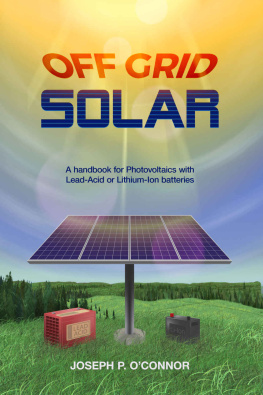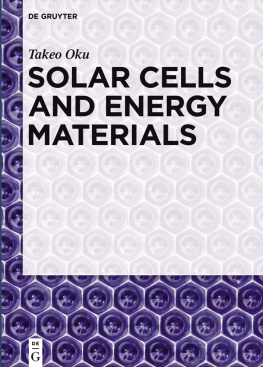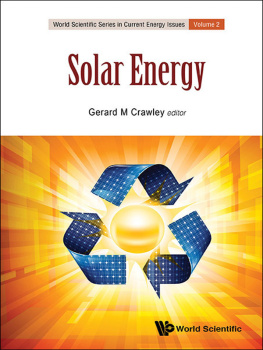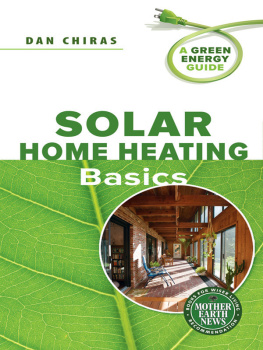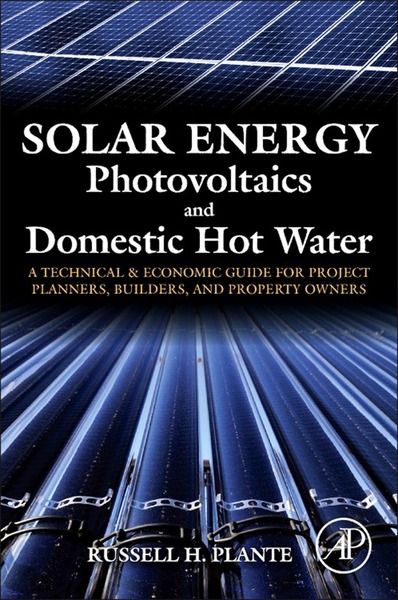Solar Energy Photovoltaics and Domestic Hot Water
A Technical and Economic Guide for Project Planners, Builders, and Property Owners
Table of Contents
Copyright
Academic Press is an imprint of Elsevier
525 B Street, Suite 1900, San Diego, CA 92101-4495, USA
225 Wyman Street, Waltham, MA 02451, USA
First edition 2014
Copyright 2014 Elsevier Inc. All rights reserved.
No part of this publication may be reproduced, stored in a retrieval system or transmitted in any form or by any means electronic, mechanical, photocopying, recording or otherwise without the prior written permission of the publisher.
Permissions may be sought directly from Elseviers Science & Technology Rights Department in Oxford, UK: phone (+44) (0) 1865 843830; fax (+44) (0) 1865 853333; email: , and selecting Obtaining permission to use Elsevier material.
Notice
No responsibility is assumed by the publisher for any injury and/or damage to persons or property as a matter of products liability, negligence or otherwise, or from any use or operation of any methods, products, instructions or ideas contained in the material herein. Because of rapid advances in the medical sciences, in particular, independent verification of diagnoses and drug dosages should be made.
Library of Congress Cataloging-in-Publication Data
Plante, Russell H. (Russell Howard), 1947
Solar energy, photovoltaics, and domestic hot water : a technical and economic guide for project planners, builders, and property owners / Russell H. Plante.
pages cm
Includes bibliographical references and index.
ISBN 978-0-12-420155-2 (paperback)
1. Solar houses. 2. Solar water heaters. 3. Building-integrated photovoltaic systems. I. Title.
TH7414.P53 2014
690.83704724dc23
2014003358
British Library Cataloguing in Publication Data
A catalogue record for this book is available from the British Library
For information on all Academic Press publications visit our web site at store.elsevier.com
Printed and bound in USA
14 15 16 17 18 10 9 8 7 6 5 4 3 2 1
ISBN: 978-0-12-420155-2
Dedication
For Kathythe constant sunshine in my life
Preface
There are many books on the market today that address the types of solar energy systems available as well as the methods used to install such systems. Most of those publications, however, do not address the fundamental question of whether or not you should even consider purchasing a solar energy system. This book will help you to understand not only whether or not such an investment will function at your specific location and satisfy your specific demand requirements, but most importantly, to determine if the system will save you money . It should not be just a Green Energy environmental issue but a decision that encompasses both practicality and economics. The information presented throughout these chapters should be of value to a diverse audience not limited to but including facility engineers and managers, project planners, real estate brokers, home builders, alternative energy dealers/installers, educators, and residential and commercial property owners.
The chapters within this book sequentially and independently address topics that will assist you in making an informed decision on whether or not to install a solar energy system for your everyday requirements. This book serves as a prerequisite to the Do-It-Yourself installation books that provide guidelines and instructions for installing Solar Domestic Hot Water (DHW) and Photovoltaic (PV) systems. The intention is to provide you with a fundamental understanding of these two types of solar alternative systems in order to make an informed decision as to whether or not such systems are practical for your specific energy demands and economical for you as a long-term investment. This book also provides you information not systematically and comprehensively available on the Internet.
You may already have a basic and fundamental understanding of Solar DHW and/or PV systems, of the components and operations involved, and maybe even a conceptual knowledge of energy costs and comparisons. Perhaps you are only interested in discerning a financial opinion of your investment as to cost payback. In part, this book provides independent topics in a logical progression regarding the evaluation and use of these technologies. In whole, this book will provide you with a fundamental understanding of these systems and guidance to evaluate the basic economic concepts involved, resulting in a comprehensive perspective of these two important alternative solar energy systems.
The predecessor to this book was published by John Wiley & Sons, Inc. in the early 1980s, entitled, Solar Domestic Hot Water: A Practical Guide to Installation and Understanding. It was written as a practical guide for the homeowner as well as a textbook for the educational market and explained the functions of all the components as well as provided installation guidelines for solar hot water systems. Prior to publication, it received positive technical feedback by nine different college professionals ensuring accuracy and consistency in content and was published when alternative energy solutions were first introduced to the market. This book significantly updates discussions relative to solar DHW and energy conversions, includes technical guidelines for photovoltaics, and explains economic considerations for both types of systems as long-term investments.
During the early 1980s, solar energy alternatives were considered important due to increasing energy prices. When the price of imported oil declined in years following, so did the importance of using solar energy as a cost savings alternative. Federal and most State energy tax credits were eliminated or simply abandoned, and America went back to the old way of doing business by continuing its dependence on foreign oil. The use of solar energy was more or less dismissed by the majority of people, setting the stage for fewer solar collector manufacturers, fewer installation and support businesses, and increased foreign oil energy dependence which exists to this day, over 25 years later. Since that time, we have done very little to develop and use alternative energies or to strengthen our own energy infrastructure. It is simply incredible to believe that so little has been accomplished in the interim. The importance of energy independence and cost savings has not changed over the years. In fact, continued growth in foreign energy dependence has decreased our economic stability. If we continue to do nothing, it should be of increasing concern to all of us that those conditions will become even worse in years to follow.
Green Energy has become a lexicon to those people concerned about our environment and our foreign energy dependence as well as to those people who believe the term is overused and extreme in its actual conception. The term solar has also received disparaging media coverage because of bad business practices, corporate bankruptcies, manufacturing company failures, extreme government regulations, and the federal governments overexuberance to channel taxpayer funds into poorly chosen business decisions. The installation of renewable active energy systems using flat plate or vacuum tube panels for solar DHW systems and the use of photovoltaic systems for the generation of electricity can be viable applications of green energy. It is the actual cost of such systems, the resultant economic savings, and an understanding of their proper applications that should be fully vetted before you make a decision to conclude whether or not solar is a viable alternative for your particular situation.



